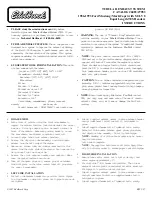
Principles of Operation
Power Flow
When the multi-disc clutch in the transfer case is disengaged, no driving torque is trans-
mitted to the front axle. All of the driving torque is then distributed to the rear axle. This is
because the input shaft (1) is splined providing a permanent connection to the rear axle
propeller shaft output flange (2). The multi-disc clutch couples the rear axle propeller
shaft output flange to the front propeller shaft output (3).
The driving torque on the front axle is increased or decreased by regulating the locking
pressure of the multi-disc clutch, providing a stepless coupling of the front axle to the
drivetrain. This depends on driving situations and road conditions. When the multi-disc
clutch is fully engaged, the front and rear axles turn at the same speed.
Driving torque distribution (front/rear) is based on available traction at each axle. For
example, when traction is identical on the front and rear axles and a driver accelerates
from a stop in first gear at full throttle, the rear axle is capable of sustaining greater driving
torque as the vehicle weight shifts from the front to the rear.
Another example is when the front axle is on a high traction surface and the rear axle is on
ice. In this case, virtually 100% of the available driving torque is transmitted to the front
axle. Based on available traction, virtually no driving torque can be supported by the rear
axle . Obviously, when more driving torque is transmitted to the front axle, driving torque
on the rear axle is proportionally reduced due to lack of traction.
20
E61 Sports Wagon
Color
Explanation
Red
Torque from engine to rear axle
Green
Controlled torque to front axle
Dark Blue
Rotation to drive multi-disc clutch
Содержание E61 Sports Wagon 530xiT
Страница 10: ...System Circuit Diagram 10 E61 Sports Wagon...
Страница 12: ...12 E61 Sports Wagon NOTES PAGE...
Страница 35: ...35 E61 Sports Wagon NOTES PAGE...
















































